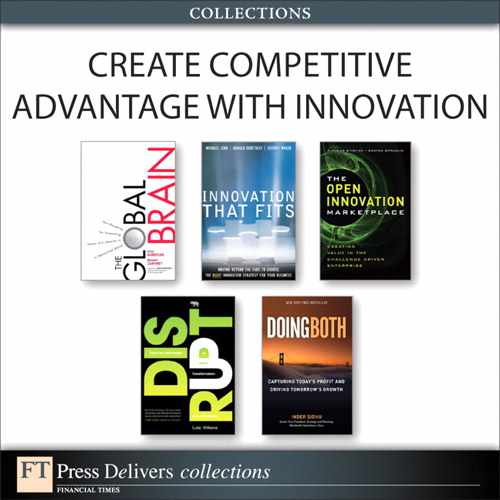Preface
Open innovation is actually a pretty straightforward concept. It’s the use of resources other than those internal to an organization, contributing in a meaningful way to an innovative outcome associated—owned if you will—by the organization that benefits directly from its distribution in the marketplace. But, as we unpack the business implications, as we examine the decision processes, as we look more closely at the organizational consequences, it is clearly a profound subject about which much has been and will be written. We feel that our contribution to that body of literature and practice is uniquely informed. As executives of InnoCentive, we have used our own business as a laboratory for understanding open processes and for examining the way innovation is practiced by ourselves and our many customers and partners, as well as the historic practices of the organizations in which we had been previously engaged. And, we strive to continually update our understanding of how and why it actually works to improve on that process for the success of our business and for the success of our customers.
InnoCentive was launched in 2001. At that time, there was no crowdsourcing or broadcast search channel to turn to for business innovation. In fact, those terms hadn’t even been coined yet. Eli Lilly and Company saw the potential for making a change in the way they innovated. They recognized that distributed in an unsearchable crowd were insights, flashes of genius, and ideas that would never be evident on job applications, resumes, or consulting brochures. They would hinge upon the uniqueness of every human experience and the chaotic way in which “aha moments” are distributed among persons of widely varying academic and career qualifications. Lilly saw the potential for tapping that ingenuity and a new business model was born. It became another “channel” in what was emerging as a rapidly growing world of innovation alternatives to “doing it yourself.”
As we worked to create a successful business around this new model, new language sprang up to characterize it. We already mentioned the subsequent coining of the terms “crowdsourcing” by Jeff Howe and “broadcast search” by Karim Lakhani. Internally InnoCentive used familiar terms in very deliberate ways. Our customers, providing challenging problems to our network, became “Seekers.” And our network was one of “Solvers.” The problems themselves were “Challenges.” And we used these descriptions as we analyzed questions like: What was the value proposition to Seekers? Why did Solvers engage? And how did the properties of the Challenge serve to effectively contribute to its solution? As we authored this book, we were aware that sometimes we meant seeker as one who seeks a solution and sometimes we meant it as a specific player in a business ecology, an entity with the titular role of Seeker. We have striven to be consistent in our use of capitals. In the end, we realized there was no perfect solution. Any single, albeit consistent, default to a rule felt awkward at times. We used our judgment. We hope it worked.
These new approaches to innovation—crowdsourcing, broadcast search, electronic requests for proposals, and public-private partnerships—were joining the more historic ranks of joint ventures, contract labs, university research, and consulting services as a growing number of channels for innovation. The new modalities were being added faster than the techniques for orchestrating and managing them were. Taken altogether, these many marketplaces, platforms, and exchanges were becoming an innovation marketplace—an Open Innovation Marketplace. And in this sense, open means not just external, it means open to any source of contribution, including the efforts of the internal staff and innovation contributors. In the chapters that follow, we will present rationale for why open is better. We will present a framework for creating value in this market reality and rethinking your innovation processes. We will show how to select appropriate channels when faced with the myriad choices and we will discuss the ways this may transform the very organizational structure of our business as these principles flow throughout.
Like most books, you can pick this one up, turn to page 1, and read it straight through. But inasmuch as we have chosen as our audience executives, foundation leaders, project managers, agency heads, and business students, we have architected the book in such a way that it also serves as its own synopsis.
After the introduction, each chapter is followed by a case study. You can read the chapter’s opening quote, the first paragraph or two, under the subheading “Overview” and the subsequent case study. In this way, the concepts are brought to life through the stories—and theoretical details and background can be later filled in as chosen. Those who might elect to read as such, should also read the synopsis of Chapters 1–8 that appears in the beginning of Chapter 9, “Leadership.”
Two chapters stand somewhat separate from the remainder. These two are intended to serve as a practicum to the main body of the text. Chapter 5, “The Selection of Appropriate Innovation Channels,” establishes a decision-making tool for selecting innovation channels after a project’s properties are defined. And Chapter 8, “The Challenge Driven Enterprise Playbook,” serves as a playbook for change and the transformation to a more virtual organization we refer to as the “challenge driven enterprise.” We recommend that they at least be skimmed for their structure even if the details are to be executed by others in the organization. And, be sure to read the critical case studies at the end of Chapter 5 and Chapter 8.
Though sources are cited, as appropriate, in the notes at the end of each chapter, we have also compiled a reading list of texts and papers that can augment the content and provide better grounding in topics that could only be covered in brief.
